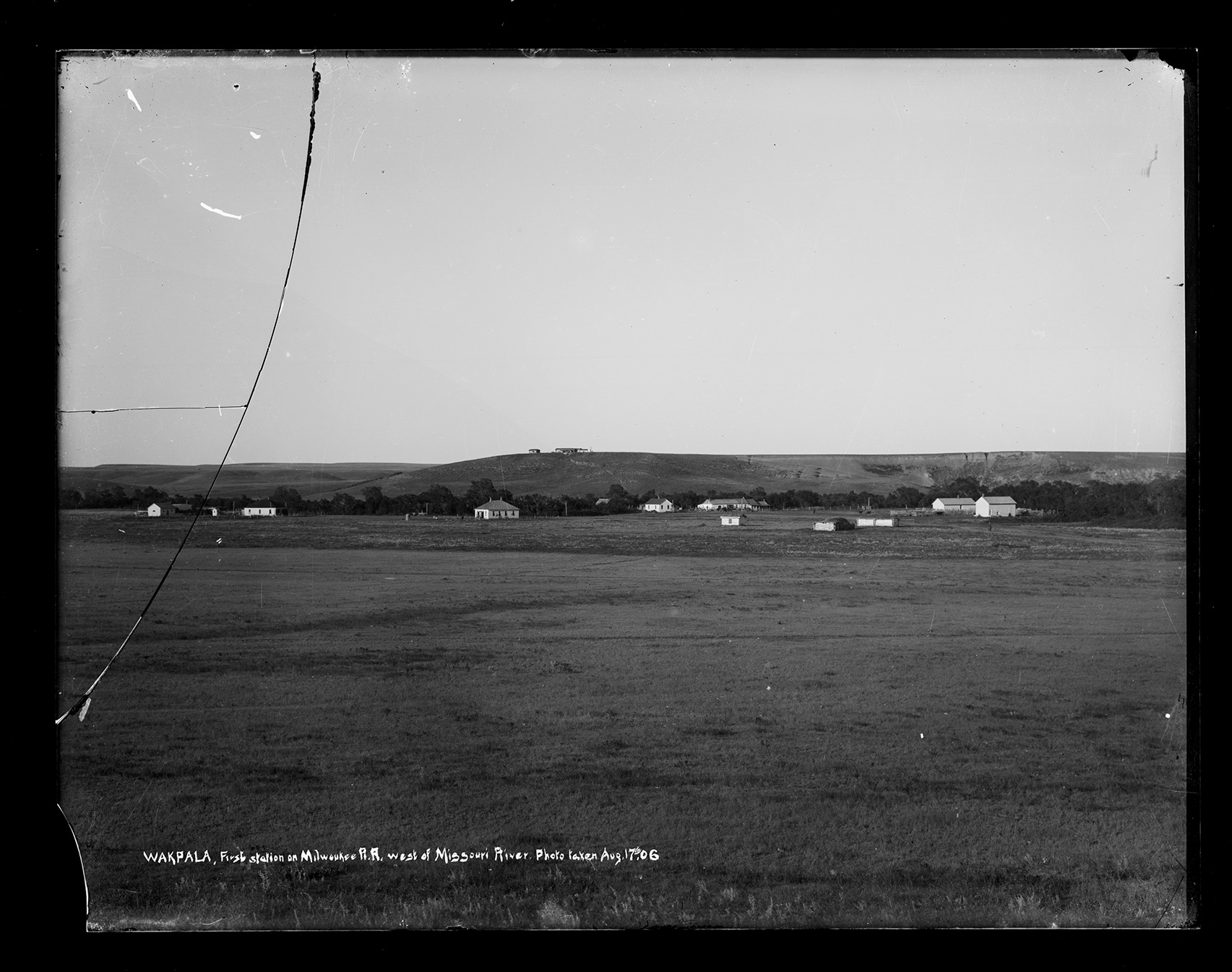Collection: 1952 - Frank Bennett Fiske
Item: 00001
Title: Wakpala, first station on the Milwaukee Railroad west of the Missouri River
Date: 8/17/1906
Creator: Fiske, Frank Bennett,--1883-1952
Inscription/Marks: [in red gouache on negative] Wakpala, First station on Milwaukee R.R. west of Missouri River. Photo taken Aug. 17th, 06. [history: https://milwaukeeroadarchives.com/Construction/HistoryofPCEConstruction.pdf ] THE MOREAU BRANCH The Moreau Branch departs from the main line at Moreau Junction near the west end of the Missouri River Bridge and extends about 62 miles in a general south and westerly direction through Corson and Dewey Counties to Isabel. The line was constructed in 1909-10 to serve the lands being opened for homestead on the Standing Rock and Cheyenne Indian Reservations. . .The construction was carried on under th supervision of a Division Engineer and Resident Engineers in the field. The Division Engineer reported to the Engineer of Construction at Miles City. The contract for the grading, bridge and culvert work, track laying and the handling of stores and supplies was awarded to McIntosh Bros., who sublet the entire line to H. A. Whittier of Billings, Montana. Outfits for the work were shipped from Billings via the Northern Pacific Railway to Miles City where they were transferred to the Chicago, Milwaukee & St. Paul Line and delivered to Wakpala. A temporary material yard was constructed at Wakpala and headquarters were established at this place for the Engineers and Contractors. A few squaw men and Indians were living on small ranches along Snake Creek, but as a whole the country traversed was undeveloped at the time of construction, and no supplies could be obtained locally. As a consequence it was necessary for the contractors to build wagon roads and transport the supplies from Wakpala. This also necessitated the construction of a ferry over the Grand River. The smaller streams were forded and as they were subject to sudden flood considerable delay was experienced in the transporting of supplies. Part of the wagon road was through gumbo soil, which made it almost impassable in wet season. . . The material for the culverts on the first 22 miles of the line were hauled from Wakpala by team. On the last 40 miles the culvert openings were cribbed and the material delivered by train after the track was laid. Cast iron pipe was used largely for culverts although in some cases concrete and vitrified pipe was used. Glass plate negative is broken into three pieces with the lower left corner missing.62 miles in a general south and westerly direction through Corson and Dewey Counties to Isabel. The line was constructed in 1909-10 to serve the lands being opened for homestead on the Standing Rock and Cheyenne Indian Reservations. . .The construction was carried on under th supervision of a Division Engineer and Resident Engineers in the field. The Division Engineer reported to the Engineer of Construction at Miles City. The contract for the grading, bridge and culvert work, track laying and the handling of stores and supplies was awarded to McIntosh Bros., who sublet the entire line to H. A. Whittier of Billings, Montana. Outfits for the work were shipped from Billings via the Northern Pacific Railway to Miles City where they were transferred to the Chicago, Milwaukee & St. Paul Line and delivered to Wakpala. A temporary material yard was constructed at Wakpala and headquarters were established at this place for the Engineers and Contractors. A few squaw men and Indians were living on small ranches along Snake Creek, but as a whole the country traversed was undeveloped at the time of construction, and no supplies could be obtained locally. As a consequence it was necessary for the contractors to build wagon roads and transport the supplies from Wakpala. This also necessitated the construction of a ferry over the Grand River. The smaller streams were forded and as they were subject to sudden flood considerable delay was experienced in the transporting of supplies. Part of the wagon road was through gumbo soil, which made it almost impassable in wet season. . . The material for the culverts on the first 22 miles of the line were hauled from Wakpala by team. On the last 40 miles the culvert openings were cribbed and the material delivered by train after the track was laid. Cast iron pipe was used largely for culverts although in some cases concrete and vitrified pipe was used. [Provenance] 10105 Frank Bennett Fiske Papers 1850-1979. 8 feet. The collection was donated by Fiske's daughter, Francine L. Peters, on July 28, 1971. The biographical sketch was written by Frank Vyzralek for the ND Heritage Foundation in December 1982. The collection was processed, and this finding aid was created by Emily E. Schultz in July-November, 2010. Images were separated from papers and transferred to Photo Archives and assigned the Photo Collection Number 1952. [source: https://milwaukeeroadarchives.com/Construction/HistoryofPCEConstruction.pdf]
Summary: Distant view of town of Wakpala Corson County (S.D.) showing residences, farms both in the valley and up on the hill top.
Red ID: PH_I_15465 Image ID: 136202 Image Notes: 1952-00001


